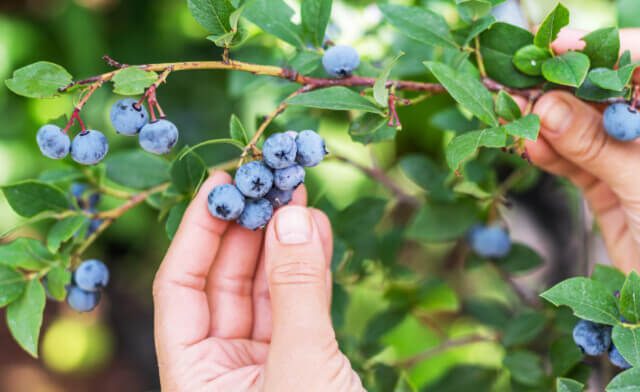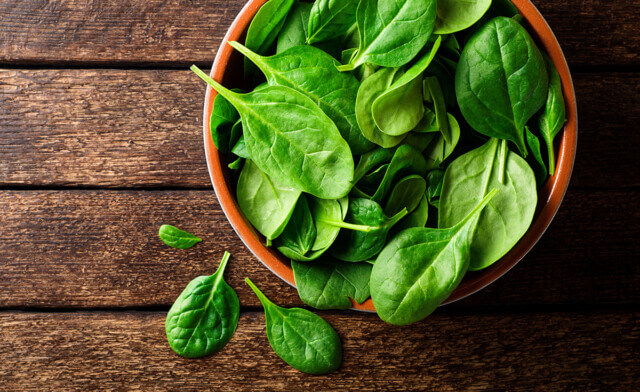The Best Puppy Food for Your Growing Dog
If you’ve just brought home a new puppy, finding nutritious puppy food for them can seem overwhelming. But don’t stress; we have plenty of the best puppy food options for a range of puppies and are here to help you learn more about puppy feeding basics.
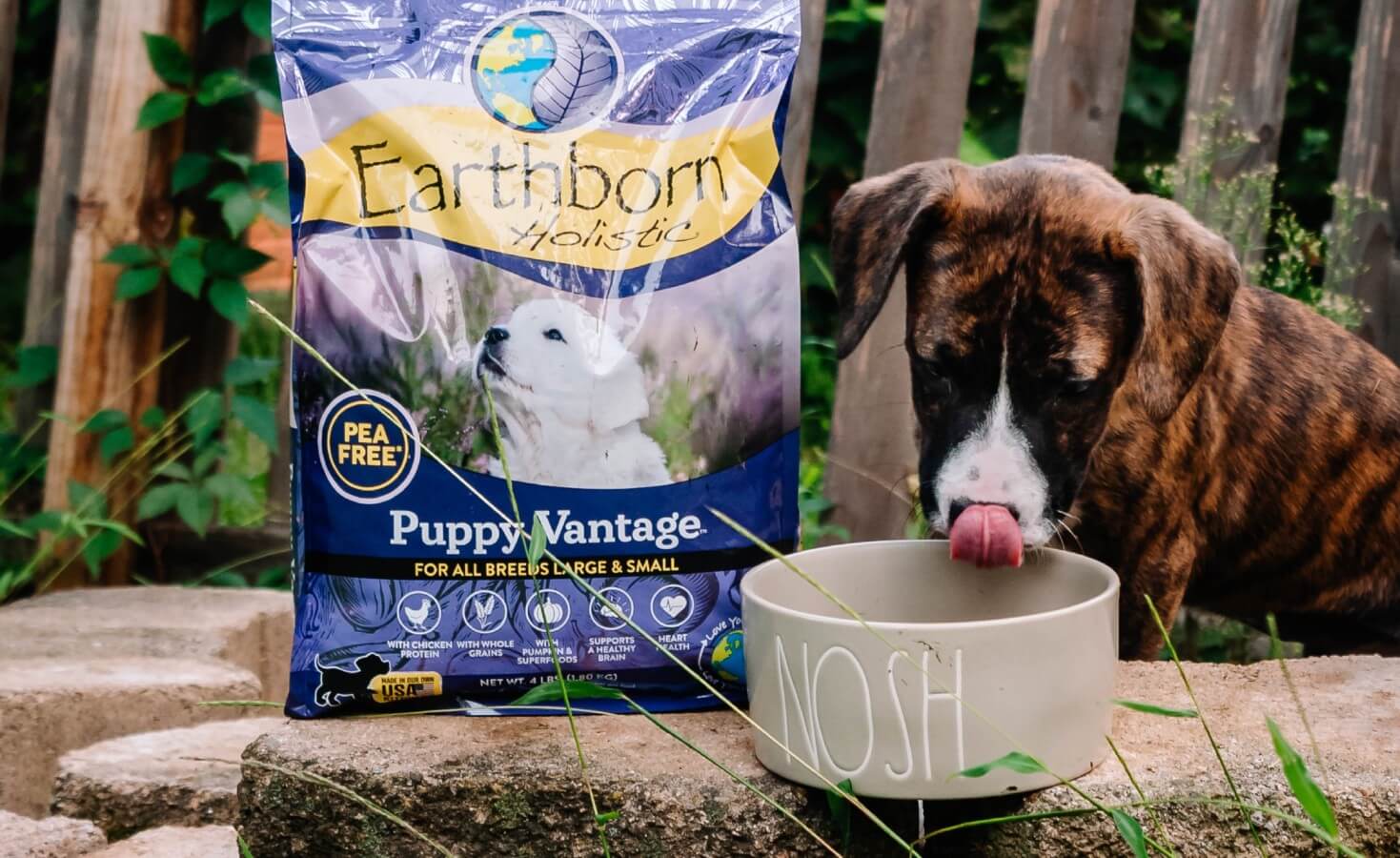
Best Dog Food for Puppies
When searching for the best dog food for puppies always check the back of the label and look for the AAFCO statement, or nutritional adequacy statement. This is especially important for puppies because the statement should include the term “growth”. For example, here is the nutritional adequacy statement for our Unrefined Roasted Rabbit recipe:
Earthborn Holistic Unrefined Roasted Rabbit Recipe is formulated to meet the nutritional levels established by the AAFCO Dog Food Nutrient Profiles for all life stages including growth of large size dogs (70 lbs. or more as an adult).
This statement confirms that this dry dog food recipe is complete and balanced and has all of the nutrients necessary for your puppy’s growth and development. In other words, an average puppy can eat Unrefined Roasted Rabbit as a healthy diet without the need for additional supplements.
Another thing to potentially look for is an all life stages recipe. These recipes offer more flexibility for families with multiple dogs and decrease the need to switch to an adult recipe as your puppy gets older. All life stages recipes have a nutritional adequacy statement similar to our Primitive Natural recipe:
Earthborn Holistic Primitive Natural is formulated to meet the nutritional levels established by the AAFCO Dog Food Nutrient Profiles for all life stages except growth of large size dogs (70 lb. or more as an adult).
This means that Primitive Natural is complete and balanced and you’re able to feed this food to your dog for their whole life because it has all the necessary nutrients for each life stage. We have a whole variety of all life stages dog food if this is what you’re looking for. Primitive Natural is made with a mix of turkey and chicken proteins as well as a tasty blend of pumpkin and sweet potatoes, but if your pup prefers a different protein we have plenty of options.
Whether you feed a puppy recipe or an all life stages recipe, the best food for puppies will have docosahexaenoic acid (DHA) in the guaranteed analysis. DHA is an omega-3 fatty acid found in fish oils that helps support healthy brain development. DHA along with a variety of other important amino acids are the building blocks that make up the healthiest food for puppies.
Best Food for Small Breed Puppies
If your puppy is a small breed, there are other things to consider when it comes to what you should be looking for. Smaller breed dogs require different nutrition, and the same goes for puppy small breeds.
In general, the best puppy food for small breeds is a high-calorie diet. Small breeds have a much higher metabolism rate than larger dogs (those little legs move faster!) so they’re able to process calories faster than large breeds. Our Small Breed recipe is a turkey-based recipe with a high calorie content (400 kcal/cup) and is also formulated for all life stages, so it has all of the nutrients necessary for your small breed puppy as well.
If turkey is not your small pup’s protein of choice we also have our Coastal Catch recipe with herring meal as the main ingredient. This recipe is developed for all life stages and has a small enough kibble for those tiny mouths to enjoy!
Best Puppy Food for Medium Breeds
Even though your puppy is not a large breed, this does not mean they are a small breed either. When searching for the best puppy food for medium breeds, take into account that your pup may need something different than a small breed.
So, what is the best puppy food for medium breeds? Our Great Plains Feast is an amazing choice of dog food when looking for the best grain free puppy food for medium breeds. Great Plains Feast is a high-quality, grain-free bison protein dog food. This all life stages recipe is sure to provide your pup with everything they need from the puppy stage all the way to the senior stage. Making it the best dry puppy food for medium breeds.
Best Food for Large Breed Puppies
Similar to small and medium breeds, large breed puppies also have more specific nutritional needs. With large breed adults, their nutritional needs are quite opposite from small breeds. Large breed dogs have much slower metabolisms than average or smaller dogs, so they require lower calories. With large breed puppies, however, this is a little different because puppy nutrition is different from that of adult nutrition.
Because puppies, even large breed puppies, have higher metabolisms so they require more calories to fuel their growing bodies. The best puppy food for large breeds is our Coastal Catch recipe. Coastal Catch is made with 365 kcal/cup and is formulated to support large breed puppies as well.
One important thing to note when looking for the best large breed puppy food is that if you’re looking to feed an all life stages formula, you need to pay extra close attention to the Nutritional Adequacy Statement. For example, our Primitive Natural recipe that we mentioned earlier is suitable for puppies and dogs alike, but is actually not suitable for large breeds or large breed puppies:
Earthborn Holistic Primitive Natural is formulated to meet the nutritional levels established by the AAFCO Dog Food Nutrient Profiles for all life stages, excluding growth of large size dogs (70 lbs. or more as an adult).
So while Primitive Natural is an all life stages recipe, you’ll need to look to other formulas like Coastal Catch or our UNREFINED recipes if you want a large breed puppy food.
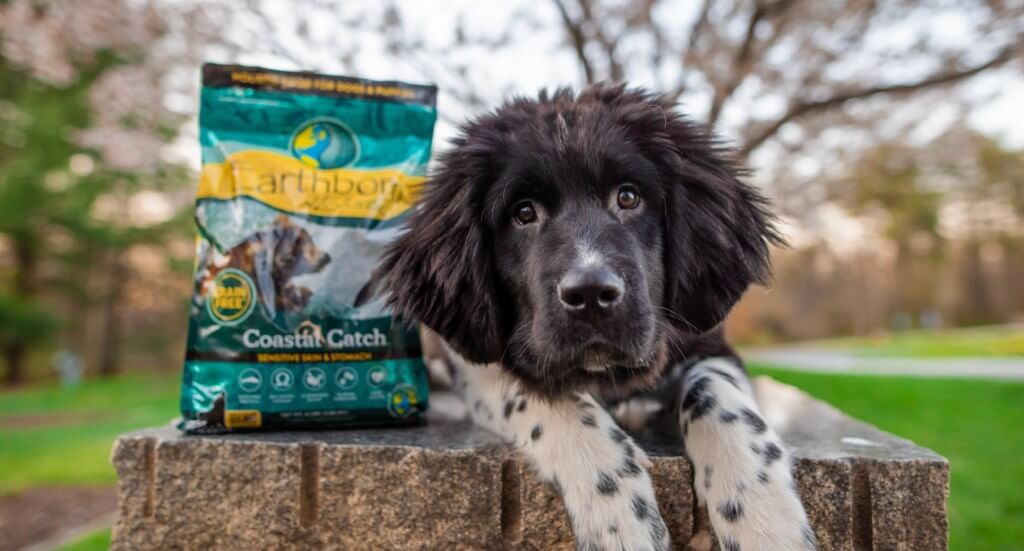
Dry Puppy Food vs. Wet Puppy Food
Determining the best type of food for puppies can be hard, especially with the rise in popularity of wet food. When questioning “Which is better dry or wet puppy food”, the answer is not straightforward. Both types of dog food can beneficial depending on the individual needs of your puppy.
There are many benefits of dry puppy food wet food cannot provide. The first being that dry kibble has many dental benefits. Dry puppy food encourages dogs to chew their food aiding in preventing tar build up. Secondly, dry food is less expensive and convenient. On average, dry dog food costs less, is easily portioned, and can be stored and left out longer than wet foods can be. If your dog is a grazer, dry kibble is probably better for your pup. Lastly, dry food is typically easier to use in food enrichment exercises like food puzzles and slow feeders. If dry food seems like the right food for you and your pup, it is time to start searching for the best dry puppy food.
While dry food has many benefits, wet food may be a better fit for your pup. One of the main benefits of wet food is that it has a high moisture content, making it a good choice for dogs who do not drink enough water or have medical issues. The use of wet food may also be better for dogs who have oral abnormalities or dental issues since it is easily chewed and digested. One of the best wet puppy food benefits is that it is typically more appealing to eat due to its aroma and flavor. This can be a useful tool if your pup is not eating. With that, wet food keeps pups feeling full longer. So, if your puppy has a never-ending appetite, wet food may be the answer.
Best Puppy Food for Allergies
Finding the best puppy food for dogs with allergies can be a whole different ball game. But first, it’s important to know how allergies in dogs work. What many dog owners don’t realize is that there is a much higher chance of your dog having food intolerances than allergies. However, we turned to Dr. Anne Huss, Earthborn Holistic’s Director of Nutrition Services:
“A food allergy is a result of a flaw in a pet’s immune system and is an abnormal reaction to normal foods triggered by an animal’s immune system. In some cases, a pet’s immune system can misidentify or misjudge safe compounds (usually proteins) as a threat which causes the body to attack–leading to a food allergy.
“A food intolerance, on the other hand, can be either an unusual reaction to normal food or normal reactions to abnormal foods that does not trigger a response from the immune system.
“Food allergies can take months to years to develop to a particular food. Once developed, the allergy will persist with a negative reaction to that particular food or allergen. On the other hand, a food intolerance will come on more quickly due to the immune system not mediating the response.”
Because allergies and intolerances are so similar and have similar symptoms, we always recommend talking to your vet when trying to decide if your dog is allergic to any foods and what the best puppy food for allergies is for your dog. They may recommend an elimination diet to hone in on the specific ingredient your dog is allergic (for example, a chicken-free dog food) to or a limited ingredient dog food, which we can help with!
A limited ingredient diet is pretty much what it sounds like–a diet with fewer and less-common allergens. For example, two of our Venture recipes are crafted for all life stages and are great for puppies with allergies. Our Alaska Pollock & Pumpkin recipe and Rabbit Meal & Pumpkin recipes are both limited ingredient diets for adult dogs and puppies with allergies alike. They’re made with fewer ingredients but still contain all of the nutrition your growing puppy needs.
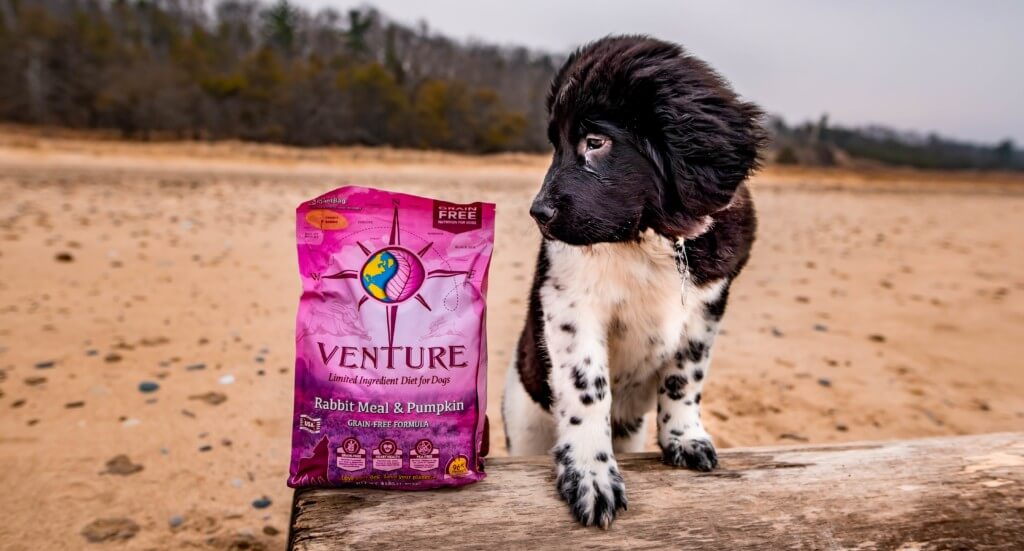
Best Puppy Food for Skin Allergies
If your puppy struggles with skin allergies, we typically recommend a diet with Omega-3 and Omega-6 fatty acids. Omega fatty acids are known to help support skin and coat health, which can help relieve skin allergy symptoms. Where are Omega fatty acids found? Fish!
Often, finding the best puppy food for dogs with skin allergies involves finding a fish-based recipe. A fish-based recipe will help tremendously with any skin allergies your puppy has developed. That being said, fish proteins are typically more popular for puppy recipes because DHA is actually an omega-3 fatty acid. So while Omegas are great for all dogs and their skin and coat, they provide extra benefits for puppies and their growth and development.
A great option for dealing with skin allergies in puppies and dogs alike is our Coastal Catch recipe. This grain-free, all life stages recipe is made with herring meal as the first ingredient and also features salmon meal and pacific whiting meal for an extra boost of Omegas. Additionally, both of the all life stages Venture recipes mentioned earlier have added Alaska Pollock Meal, aiding in Omega fatty acids for healthy skin and coat for your puppy with skin allergies.
Best Puppy Food for Food Allergies
Like humans, dogs often are allergic to certain foods. If your pup is allergic to their food, we suggest switching to a limited ingredient diet. A limited ingredient food may be the best puppy food for dogs with food allergies because it has fewer ingredients, meaning there are less things for your pup to react poorly to. Limited ingredient recipes typically include unique protein alternatives, such as duck or rabbit, that your dog has probably not been exposed to. Therefor, your pup has not been able to develop an allergy to it.
If you think a limited ingredient diet is right for your pup, our Rabbit Meal & Pumpkin is the best puppy food for food allergies. This high-quality lamb protein recipe is designed to support you pup from their puppy stage all the way to adulthood. Providing them with a rich source of key nutrients and fiber, while helping aid digestion without common allergens like grain and gluten making it the best puppy food for sensitive stomachs.
Wondering How Much Food to Give to a Puppy? Let’s Review Our Guide
Just like adult dogs, how much puppies should eat depends on a variety of factors. While you should always consult with your veterinarian when trying to determine exactly how much food to give a puppy, you can get a starting point by looking at the puppy feeding chart on the back of your puppy’s food bag.
To read the feeding chart, simply find your puppy’s age and weight and then the corresponding amount of food you should feed based on that food’s puppy feeding guide. This will give you a great starting point for how much food to give a puppy a day. For example, here’s a feeding chart from our Unrefined Roasted Rabbit recipe recipe:
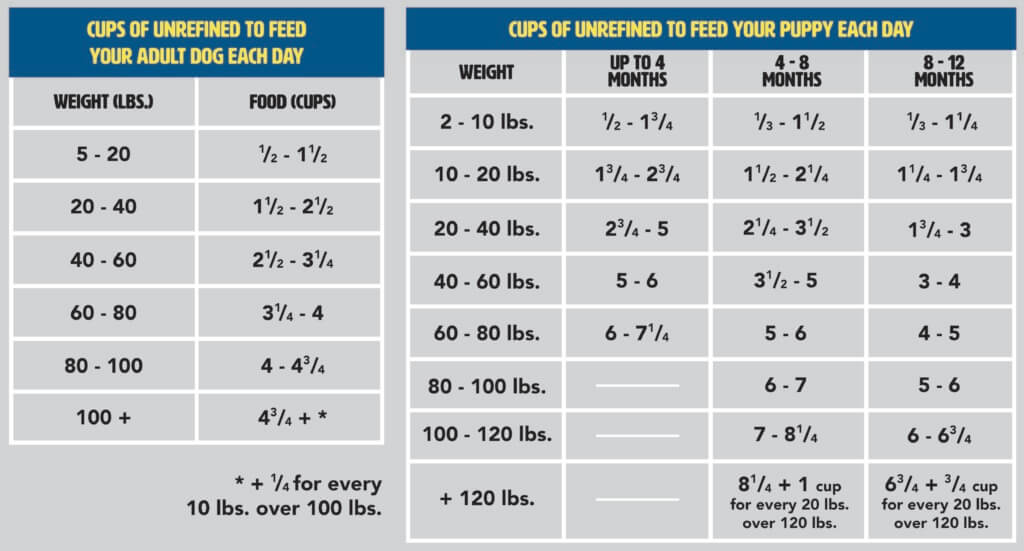
If you had a puppy that was 5 months old and weighed 25 pounds, you would feed between 2 and 3¼ cups of Puppy Vantage per day. Again, this is meant to be a starting point and your vet will be able to help you determine the exact amount. Another important note is that the feeding chart for each recipe is different, so just because you feed 2 cups of Puppy Vantage doesn’t mean you’ll need to feed 2 cups of another recipe.
How Long Do Puppies Need to Eat Puppy Food?
Generally, most puppies are ready to be switched to adult dog food when they reach 12 months of age. However, when questioning “how long do puppies need to eat puppy food?” remember that it defers with every dog. Puppies grow quickly, so it’s important to make sure you’re waiting to switch their food until they’re reached maturity so their nutrition can keep up with their growth. That being said, if you’re feeding an all life stages formula, switching to an adult food isn’t necessary unless you want to, which we’ll discuss later.
However, there are exceptions when it comes to switching from puppy food to adult food. For example, large and giant breed dogs should remain on puppy food until they reach maturity at about two years old. Because of their size, it takes longer for their bodies to grow and mature. You should always consult your veterinarian before switching foods to make sure you’re feeding a food that meets your dog or puppy’s individual needs.
How to Gradually Switch Dog Food for Your Puppy
Once you’ve determined how long you should feed your dog puppy food, it’s important to know how to gradually switch dog food. If you’re feeding an all life stages formula you’re good to go, but if you’re wondering how to switch dog food from a high-quality puppy food recipe to an adult recipe there’s a specific way to do it to avoid problems.
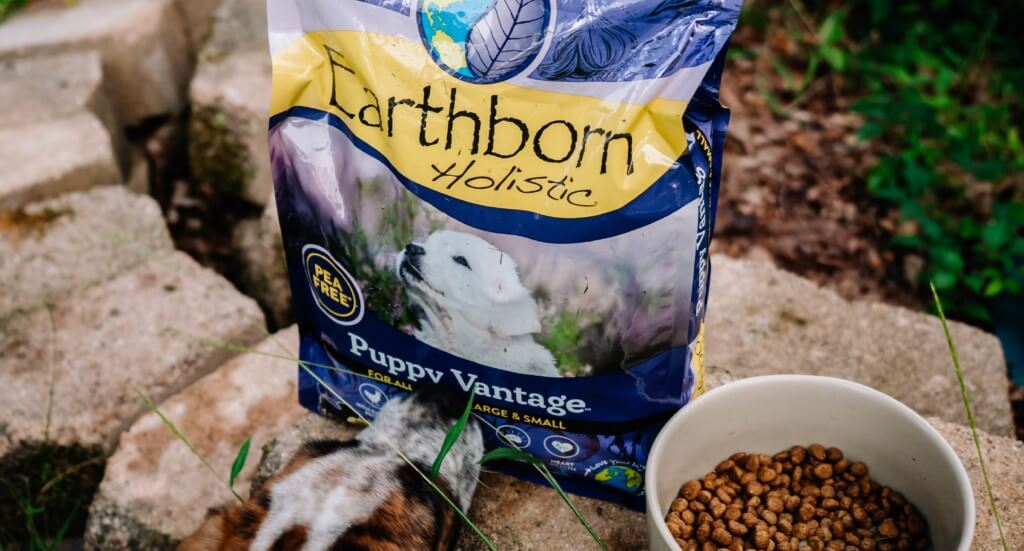
Switching dog food cold turkey is typically not recommended, as it can lead to major stomach upset for your dog or puppy. Instead, make sure you’re switching from the old food to the new food over a course of seven days (aka the seven day switch). This allows your pup to grow familiar with their new food and it helps alleviate tummy troubles that come from switching to a new food too fast. Here is the recommended breakdown of the seven day switch:
- Days 1 & 2 – 25% new food, 75% old food
- Days 3 & 4 – 50% new food, 50% old food
- Days 5 & 6 – 75% new food, 25% old food
- Day 7 – 100% new food
Once you learn how to gradually switch dog food, you’ll use the same process throughout the rest of your puppy’s life if you’d like to switch their food. Even adult dogs can get an upset stomach from switching their food too quickly.
In the end, it’s important to take into consideration your own puppy’s nutrition and take time to talk things out with your vet to make sure your puppy is getting all of the nutrients they need to support their growth. All puppies are different, but at Earthborn Holistic we’re proud to have the perfect recipe for every paw–even the small ones.
Need help choosing a puppy dry food recipe? Send us a message and we’ll be happy to help!


